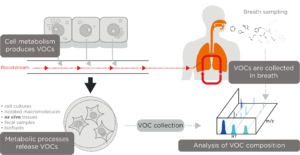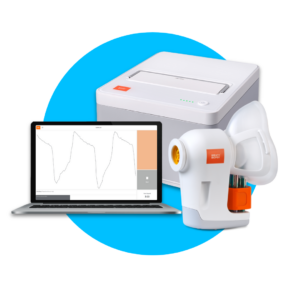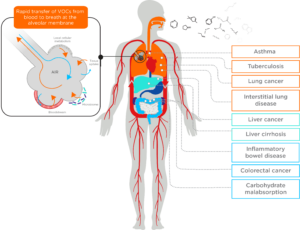Insights from the Authors : Breath VOCs as a Biomarker Platform
Published on: 25 Jul 2024
In our latest blog as part of Owlstone Insights, we got the chance to speak to Hsuan Chou (Tina), Lucy Godbeer, and Madeleine Ball, who recently a published review article titled ‘Progress and challenges of developing volatile metabolites from exhaled breath as a biomarker platform’ in the journal ‘Metabolomics.’ Tina is a senior biomarker scientist, Lucy is a scientific marketing associate, and Madeleine is a scientific content writer here at Owlstone Medical. We asked them some questions regarding their paper surrounding the analysis of volatile organic compounds (VOCs) as breath biomarkers.
The focus of the paper is on the use of VOCs, what are they and what are their benefits?
‘Over the past few years, interest surrounding the use of VOCs for both research and clinical purposes has greatly increased. VOCs are compounds that are gaseous at room temperature and have gained popularity due to their potential to act as biomarkers for a wide range of clinical purposes. VOCs arise from a multitude of metabolic processes, meaning they can serve as indicators of many disease states in which these metabolic processes are altered.’
‘Specifically, the detection and analysis of VOCs in exhaled breath has been of particular interest due to its non-invasiveness, ease of repeat sampling, low cost, and accessibility. VOCs can diffuse from their point of origin into the bloodstream and be exchanged into the air in the lungs to be exhaled in the breath. Despite its many benefits, there have been no VOC breath biomarkers that have successfully been implemented in a clinical setting at this time.’
What are some of the innovations that have been made to progress the clinical implementation of these breath biomarkers?
‘In the paper, we highlight the current issues limiting the translation of breath VOC biomarkers into the clinic, as well as the advances made to overcome them. For example, to overcome hurdles in breath collection, Owlstone Medical has developed the ReCIVA® Breath Sampler to improve breath sample collection and to isolate specific breath fractions, as well as the CASPER® Portable Air Supply that standardizes the inhaled air of users by filtering out background contamination.’
‘We also discuss the difficulty of achieving sufficient sensitivity in on-line breath sampling approaches, such as real-time breath analyzer devices, and other considerations of breath analysis, such as eliminating background contaminating VOCs and successful identification of candidate biomarkers.’
You previously mentioned that VOCs arise from many different metabolic processes to indicate several disease states. What diseases have shown promise for the use of breath biomarkers?
‘In our paper we identify key research papers that look at breath VOCs in a wide variety of disease areas. These disease areas include respiratory, infectious, gastrointestinal, and liver diseases. Within each disease area, recent key papers are critically reviewed and the findings on the feasibility of utilizing breath VOC technologies for a range of applications, including diagnostics and treatment responsiveness, are presented.’
Other than in diseases, what are other potential applications of using breath VOC biomarkers?
‘In our review we discuss the potential for the use of breath VOC biomarkers throughout the drug development stages. Specifically, in preclinical phases to develop novel biomarkers and in clinical trials to monitor treatment response and drug pharmacokinetics/pharmacodynamics.’
We are world leaders in breath VOC research. We are here to help you include breath analysis in your research across multiple disease areas and clinical contexts. You can get in touch with our experts to discuss how our technology can be incorporated into your biomarker discovery workflow.



